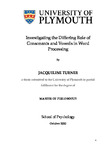Investigating the differing role of consonants and vowels in word processing
| dc.contributor.supervisor | Floccia, Caroline | |
| dc.contributor.author | Turner, Jacqueline | |
| dc.contributor.other | Faculty of Health | en_US |
| dc.date.accessioned | 2020-10-26T13:24:42Z | |
| dc.date.issued | 2020 | |
| dc.identifier | 367200 | en_US |
| dc.identifier.uri | http://hdl.handle.net/10026.1/16595 | |
| dc.description.abstract |
According to Nespor, Peña, and Mehler (2003), there is an asymmetry between consonants and vowels in language processing, with consonants being more involved at the lexical level, and vowels serving as preferential cues for grammar and prosody. The privileged role of consonants during lexical access has been demonstrated in adults across numerous languages. This consonant bias has been hypothesised to occur at the phonological level and at the earliest stages of language acquisition. The aim of this thesis is to investigate these claims in adults and toddlers. Speech sounds fall along a sonority hierarchy (see Chapter 1), and so the contrast between consonants and vowels are not easy to define. Thus, the introduction will explain why this contrast has a special status in the study of language. Chapter 2 will trace the story from the perceptual implications found in the adult literature. The adult experimental section (Chapter 3) investigates whether the consonant bias originates purely at the phonological level. Two identical priming experiments using both transposed and replaced stimuli were designed to tap onto either phonological or orthographical levels of processing. In experiment 1, an auditory adaptation of the original study by Lupker, Perea and Davis (2008), we found that primes sharing consonants (e.g., BENIFET and BENAFOT) facilitated lexical access (BENEFIT) more effectively compared to primes sharing vowels (e.g., BEFENIT and BETEMIT). In experiment 2, we found the same results as Lupker et al., of no main advantage of consonants over vowels when presentation of words was visual. Our results confirmed that the consonant bias requires more than just the activation of orthographic units, as it only occurred at the phonological level. Overall, we found that the nature of the consonant bias is phonological, and the origins of the consonant transposed letter effect is orthographic. Chapter 4 reviews the different positions around the emergence of the consonant bias. Age-related differences have been found across several languages. Thus, the infant review will trace the story from the associated developmental challenges. The developmental experimental section (Chapter 5) explores the current ambiguity found across languages in toddlers by testing 21-month-old English toddlers. Using a preferential looking paradigm, two tasks using familiar words with either familiar distractors or unfamiliar distractors were designed to investigate differences between the perception of consonants and vowels in lexical processing. By using mispronunciations of familiar words (e.g., CAT) occurring on the onset consonant (e.g., GAT), medial vowel (CET) or coda consonant (CAD), we also looked at a potential consonantal position effect. In the first experiment which used familiar distractors, we unexpectedly found no main effect of mispronunciation. To increase sensitivity to mispronunciations, Experiment 3b used novel objects as the distractors. This time, whilst English toddlers did not exhibit a consonant bias, they appeared to make use of phonetic information incrementally. This thesis offers a unique contribution to the consonant and vowel debate, by establishing that the consonant bias predominantly occurs at the phonological level, and that the consonant bias does not emerge for English toddlers at the onset of language acquisition. | en_US |
| dc.description.sponsorship | ANR | en_US |
| dc.language.iso | en | |
| dc.publisher | University of Plymouth | |
| dc.rights | Attribution-NoDerivs 3.0 United States | * |
| dc.rights.uri | http://creativecommons.org/licenses/by-nd/3.0/us/ | * |
| dc.subject | consonants | en_US |
| dc.subject.classification | MPhil | en_US |
| dc.title | Investigating the differing role of consonants and vowels in word processing | en_US |
| dc.type | Thesis | |
| plymouth.version | publishable | en_US |
| dc.identifier.doi | http://dx.doi.org/10.24382/905 | |
| dc.rights.embargodate | 2021-10-26T13:24:42Z | |
| dc.rights.embargoperiod | 12 months | en_US |
| dc.type.qualification | Masters | en_US |
| rioxxterms.funder | Economic and Social Research Council | en_US |
| rioxxterms.identifier.project | Investigating consonants and vowels in language | en_US |
| rioxxterms.version | NA |
Files in this item
This item appears in the following Collection(s)
-
01 Research Theses Main Collection
Research Theses Main



